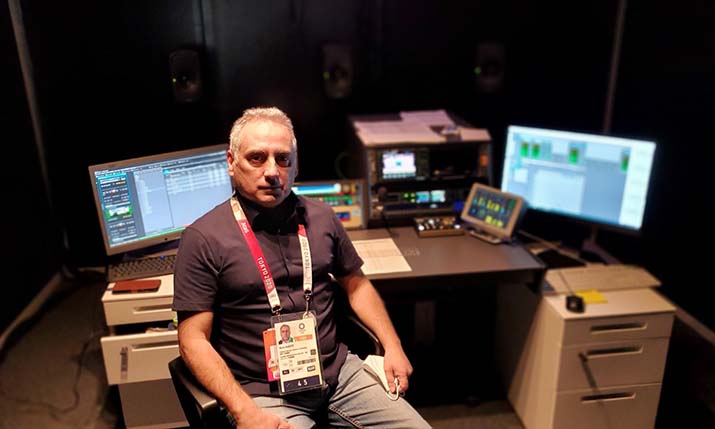Olympic Broadcast Services’ Nuno Duarte speaks from Tokyo on taking the roof off of sound design

Olympic Broadcast Services’ Nuno Duarte, hard at work in Tokyo during the 2020 Olympics
Nuno Duarte, Olympic Broadcast Services (OBS) sound design and audio manager, has one of those jobs that most audiophiles dream of. Yes, it may be at a scale that could turn the dream into a nightmare, but being able to create a sonic landscape for Olympic events that folds the listener not only into the venue, but the field of play, is something every sound designer would love to tackle.
The big news this year was the rollout of 5.1.4, or what also may be known as 9.1. The big difference from 5.1 Surround Sound is the addition of four channels that are heard from above.
“Day one after the Opening Ceremonies we had all venues in production with 5.1.4 and no issues,” Duarte says. “All the A1’s quickly got the point of what it was we wanted, and we had 36 venues up with guys doing it for the first time. The results have been fantastic and both experts and non-experts can tell it is more immersive.”
Sound design and how to listen
At first blush, adding in four more channels to a mix may sound like a daunting task, but Duarte says the goal was to make it easy for the mixers. More equipment not only makes things more complicated, but also introduces new points of failure.
“We don’t add more people, and the only additional equipment is a specific microphone and four speakers [in the mixing area],” he says. “And now manufacturers have to start working on the details like the proper metres. But it’s not a huge investment: it’s about the sound design and how to listen.”
Duarte says one or two mics is all that is needed to give the perception of height.
“We have the same Surround mics, same crowd mics, we just add one more block: something coming from above,” he says. “One microphone can cover the sound field.”
The difference when listening to an event in Surround Sound and then flipping to 5.1.4 is immediately noticeable. While Surround Sound tends to put the emphasis on hearing an instrument or effect in a corner of the room, the 5.1.4 experience seems to expand the size of the room. It sounds as if the roof has been raised (or taken off for an outdoor event,) and effects that were once stuck in the corner are much more present. That, says Duarte, creates the auditory space to do even more.
“You have to get to the details,” he explains. “Ambience is the background and then you can start building the sound of the sport on top of the crowd. And the more immersive and the more you feel like you are inside the venue, the more space you have to add the details.”
Moving forward with discrete mics
Duarte says Federations are important partners in the effort and their cooperation is crucial.
“We had fantastic results in sailing as we have mics on the athletes and quality of the production increased a lot as you can hear what is happening on the boats and hear the athletes talk,” he says.
Like the sailing proved, an important step forward will require more microphones that are smaller and more discrete. Big shotgun mics for a track and field event are being replaced by smaller mics that can be mounted on a hurdle or apparatus and deliver the same effect.
“It lets you get closer to the athlete and the sound source, but it is also less intrusive on the picture,” he says.
The OBS 5.1.4 audio effort is agnostic with respect to encoding formats like Dolby or MPEG-H.
“We want to give the material a longer legacy,” says Duarte. “Rightsholders can choose to encode in Dolby or MPEG-H and add in commentators and additional objects. But our base is there for the immersive needs.”
Anyone who watched the Games saw the lack of fans in the stands and Duarte says that sound banks were prepared for worst case scenarios that didn’t occur as fellow athletes, coaches, and officials often provided enough audio ambience.
“There is nothing like the human sound source as we react better than any machine,” he says of fake crowd noises. “Our audio plan changed very little as we would just adjust the microphones away from the empty stands and toward the stands that had people.”
It is also worth noting that the empty stands allowed for more audio details to be heard from the field of play. Simply put, viewers will want to keep hearing those details even when the fans return so look for OBS to work with the federations to continue to deliver those details.
The next big challenge, and it will be on the to-do list for the Winter Games in Beijing next February, is how to add effects from above to outdoor events like road races.
“There is sound there, like the noise of the people or the city,” he says. “To figure that out you need to leave the audio gallery, go out, and listen.”
